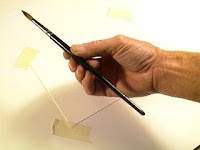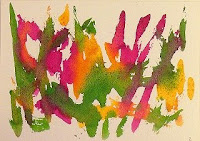 2. PINCH
2. PINCHHold your brush like you are picking up a pencil from a table, pinching it between your thumb and fingers. We'll call this grip the Pinch because you are using a pinching action to pick up your brush. As you run through this exercise you can loosen the grip to allow the brush some travel, but only use your fingertips to hold the brush when painting. You can use 2 to 4 fingertips to hold your brush. I found 3 worked best for me.
Pre-mix some puddles of colors on your palette and prepare to play. And I mean that in the best sense. Position your brush parallel with your paper, loosen your wrist and start seeing what strokes you can make as you hover over the paper. You won't have much control, but in some artistic situations that may be exactly what you need. Notice the brush's resistance to upward, pushed strokes and the ease of pulling strokes toward you, or downward.
 Most of the control is in your arm, wrist, and fingertips. Vertical strokes are easiest to pull but erratic to control in width. The wash of the stroke may be broken because you cannot apply the same pressure to the brush as you can with other grips. This same lack of pressure gives a unique texture when you move the brush side to side across your paper. Note that the arc of your horizontal strokes is controlled almost entirely by your arm.
Most of the control is in your arm, wrist, and fingertips. Vertical strokes are easiest to pull but erratic to control in width. The wash of the stroke may be broken because you cannot apply the same pressure to the brush as you can with other grips. This same lack of pressure gives a unique texture when you move the brush side to side across your paper. Note that the arc of your horizontal strokes is controlled almost entirely by your arm.














